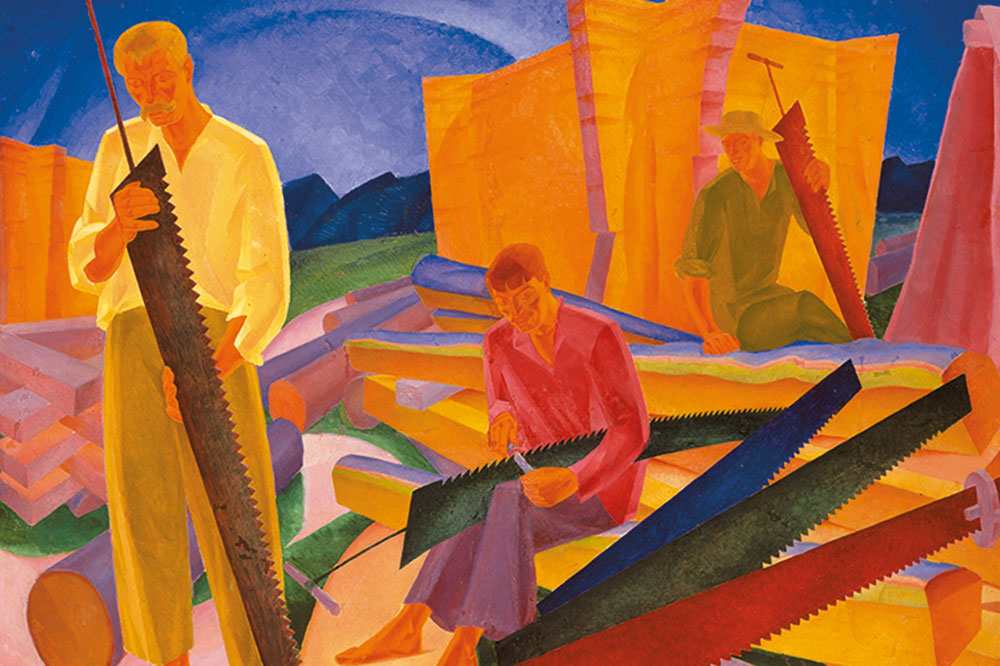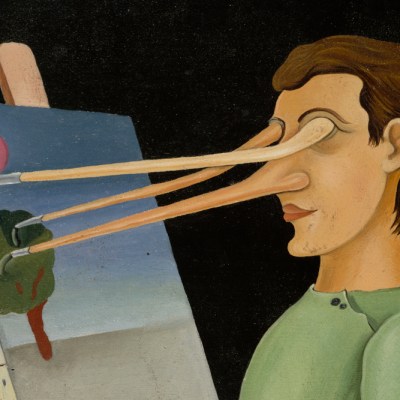From the March 2023 issue of Apollo. Preview and subscribe here.
In November 2022, 51 paintings, sketches and collages from the National Art Museum and the Museum of Theatre, Music and Cinema in Kyiv were loaded on to trucks in secret and despatched on a perilous five-day journey across Europe just before the capital was subjected to bombardment. The chosen route was careful to avoid potential military targets on the road to Lviv, but the stray missile which landed in the Polish village of Przewodów caused the border to close. Only after 12 hours of negotiations by the Ukrainian ambassador to Spain was the convoy allowed to continue its journey to the safety of Madrid.
In his video message at the opening of the exhibition at the Museo Nacional Thyssen-Bornemisza, President Volodymyr Zelensky declared the display to be ‘a vision of what Russia is trying to destroy’. The renewed threat of erasure pertains not only to physical works of art, but also to conventional narratives about modern art in which Ukraine has barely figured until now, despite the efforts of specialists dating back to the 1980s. It is a situation the exhibition seeks to address. Here there is a battle to be fought on two fronts, the first against long-term efforts by the Russian establishment to deny the existence of an autonomous Ukrainian culture. In 2014 Yulia Lytvynets, director general of the National Art Museum of Ukraine, summed up the situation when she explained why Kyiv was not associated with art in the same way as other capitals: ‘Let us be frank: for a long time Ukraine was an occupied territory. Our art was nullified in every possible way.’ Through systematic dispersal, she explained, a museum boasting 1.5 million objects in 1919 then contained just 40,000. The other campaign is to challenge lingering misapprehensions which sprang up in the West after avant-garde works in Soviet cities began slowly to be rediscovered during the Khrushchev ‘Thaw’ in the late 1950s. The artists of Ukrainian modernism have invariably and misleadingly been classed as ‘Russian’ and since most of them claimed more than one national identity, it is certainly a fraught subject. Malevich, who was born and grew up in Ukraine to Polish parents, pursued his artistic career mostly in Russia; Oleksandr Bohomazov never went abroad, but close inspection of his iridescent canvases reveals that he continued to sign his work with the Russian initials ‘A[leksandr]. B.’ even after the declaration of an independent Ukrainian republic in 1917.

Like the Ukrainian nation, so long a borderland split between empires, its modernist movement is a patchwork quilt of artistic styles, religious identities and political allegiances that are well reflected at the Thyssen-Bornemisza (and will be in evidence when the show travels to Cologne). Some of the names are familiar: five striking canvases by Alexandra Exter, Volodymyr and Davyd Burliuk, Wladimir Baranoff-Rossiné and Sonia Delaunay are drawn from the museum’s own collection of 20th-century European art. The work of most of the other less well-known artists represented, such as Vasyl Yermilov, Anatol Petrytskyi and Mykola Kasperovych, will be a revelation. The exhibition is chronologically organised to chart the trajectory of the artistic renaissance which took off in Kyiv and other cities after the seismic reforms of 1905, when the ban on the Ukrainian language was lifted in the Russian empire. International modernist trends arrived all at once in the new permissive conditions, as manifested in first section of the exhibition, which is devoted to the home-grown movement of ‘Cubofuturism’, popular in both Russia and Ukraine. Next comes the Kultur Lige, the secular Jewish organisation founded in 1918 to promote Yiddish culture. Radical Cubist canvases by Issakhar Ber Ryback and Marko Epshtein, as well as an abstract composition by El Lissitzky, were produced under its auspices. From there we move to the extraordinarily inventive world of Ukrainian stage design after the Revolution, as spear-headed by the theatre director Les Kurbas and the choreographer Bronislava Nijinska. Alexandra Exter travelled regularly to Paris after graduating from the Kyiv Art School in 1906, and played an important cultural role in her home city before the First World War by acting as a conduit for the latest ideas of the Parisian avant-garde. She continued to be a key figure in Kyiv modernist circles during the upheavals of the Ukrainian War of Independence. Other sections of ‘In the Eye of the Storm’ explore experimental work produced in the equally turbulent years from 1919–34 when Kharkiv was the capital of Ukraine, as well as the diverse trends embraced by the Kyiv Art Institute before Stalinist repression brought them to an abrupt end in the 1930s. These include the neo-Byzantine school derived from Ukrainian traditions and founded by Mykhailo Boichuk. There are surprising connections between Boichuk’s work and Malevich’s return to figurative painting at the end of the 1920s, when he was based at the Institute. A distinguishing feature of Ukrainian modernism throughout all these different phases is an intensely polychromatic palette directly inspired by the colours of the country’s still thriving folk culture, the exuberance of which is intimately connected with the bounteous harvests of its fertile southern lands. Malevich’s austere Suprematist canvases take on a new meaning seen in the context of the Ukrainian love of decorative ornamentation, which is often geometric and symbolic.

An informative and wide-ranging accompanying book, edited by the exhibition’s Ukrainian curators Konstantin Akinsha, Katia Denysova and Olena Kashuba-Volvach, and produced in record time, continues the important work of restoring Ukraine’s rightful place in the history of modernism. In the eye of the current geopolitical storm, it is sad to see the groundbreaking 2006 exhibition ‘Crossroads – Modernism in Ukraine, 1910-1930’ acknowledged only in a footnote. Conceived by the Russian émigré collector Nikita Lobanov-Rostovsky and Dmytro Horbachev, Ukraine’s leading scholar of modernism, it travelled from Kyiv to Chicago and the Ukrainian Museum in New York with the aim of presenting Kyiv and Kharkiv as major centres of artistic innovation. It included many of the paintings on show in Madrid, as well as works by other notable Ukrainian modernists not represented here, among them Alexander Archipenko, Vsevolod Maksymovych, Maria Syniakova and Vladimir Tatlin. Both exhibitions are important stepping stones on the long overdue journey to recognising Ukraine’s distinct and rightful place in the history of modern art.
‘In the Eye of the Storm: Modernism in Ukraine, 1900–1930s’ is at the Museo Nacional Thyssen-Bornemisza in Madrid until 30 April.
From the March 2023 issue of Apollo. Preview and subscribe here.



